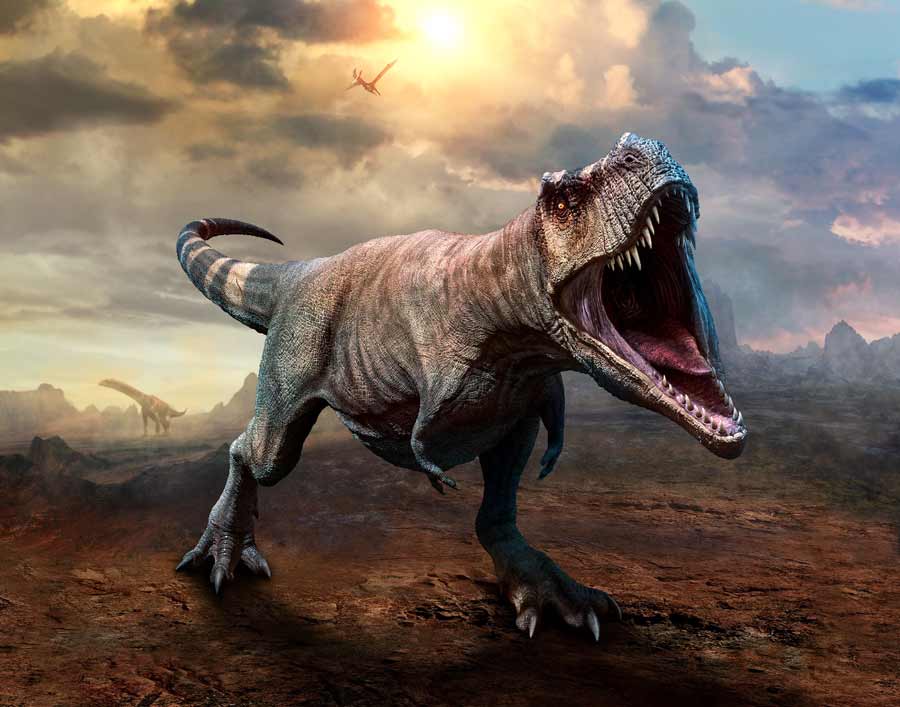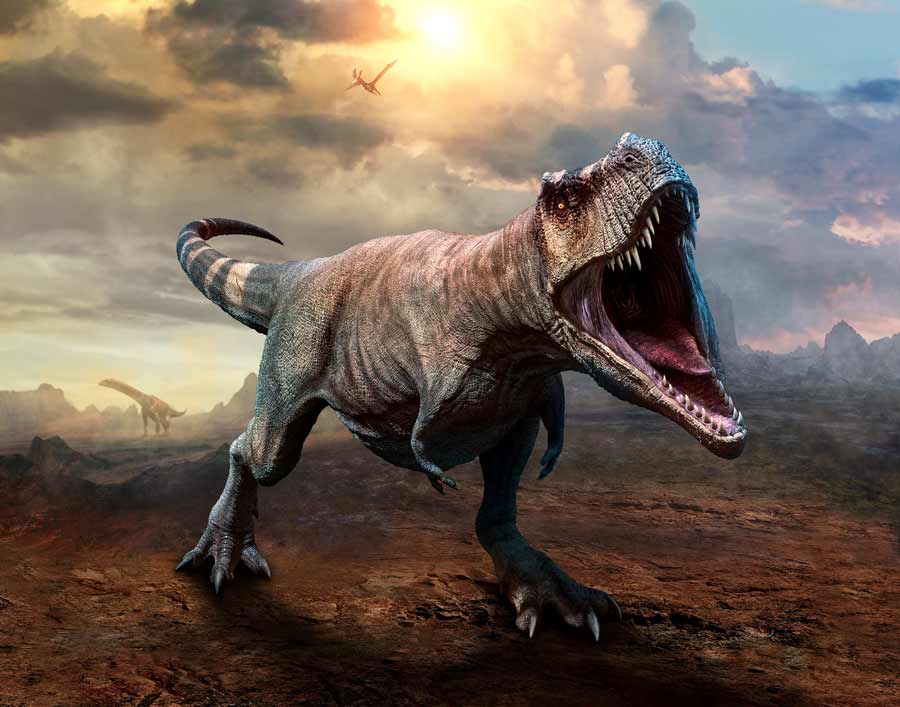

As the most ferocious dinosaur, Tyrannosaurus rex once prowled the lands that now comprise North America with impunity. And if the conclusions of a new research project are correct, their behavior may have been even more fearsome and intimidating than previously imagined. According to an article published on April 19 in the open access journal PeerJ: Life and Environment, Tyrannosaurus rex was most likely not a solitary hunter, but instead worked in packs, to chase down, surround, and voraciously consume the animals they depended on for sustenance, much like wolves.

A circular display of Tyrannosaurus rex skulls. (Kumiko from Tokyo, Japan / CC BY-SA 2.0)
Tyrannosaurus Rex: The Complex Truth Finally Emerges
This fascinating and somewhat discomfiting discovery emerged from a study conducted by a team of paleontologists working with the U.S. Bureau of Land Management (BLM) office in Utah.
The scientists performed an extensive analysis of a diverse collection of Tyrannosaurus rex bones found at a fecund Cretaceous-period fossil site in southern Utah, which is located near the Grand Staircase-Escalante National Monument. This site is known colloquially as the “Rainbows and Unicorns Quarry,” in recognition of all the rare fossils (the “unicorns”) that have been unearthed there.
Paleontologist Alan Titus, who discovered the Rainbows and Unicorns site in 2014 and is one of the lead authors of the PeerJ study, says that the group of deceased and fossilized Tyrannosaurus rex specimens were the victims of a massive flood that drowned them and washed their bodies into a lake. They lay on the bottom, grouped together and undisturbed, for millions of years, until climatological and geological changes dried the lake and created a river (also now gone) that eroded the soil and brought the bones back up to the earth’s surface.
“We used a truly multi-disciplinary approach (physical and chemical evidence) to piece the history of the site together,” explained Celina Suarez, a University of Arkansas geologist and study participant. “The end-result [was] that the tyrannosaurs died together during a seasonal flooding event.”
The members of the BLM research team see their findings as offering indirect but clear evidence of group dynamics in action among the Tyrannosaurus rex specimens in question. Their cooperative behavior would have been survival-oriented, centered around group hunting and perhaps allowing for extended parental care as well, the scientists postulate.
“The new Utah site adds to the growing body of evidence showing that tyrannosaurs were complex, large predators capable of social behaviors common in many of their living relatives, the birds,” said research project participant Joe Sertich, who is the dinosaur curator at the Denver Museum of Nature and Science. “This discovery should be the tipping point for reconsidering how these top carnivores behaved and hunted across the northern hemisphere during the Cretaceous.”

A family of Tyrannosaurus rex dinosaurs on the run. (Orlando Florin Rosu / Adobe Stock)
Slow and Steady Wins the Race
Earlier evidence to support the thesis that Tyrannosaurus rex hunted in packs emerged in 2020, when Canadian scientists released the results of their study of tyrannosaurus’ physiology and anatomy in the May edition of the journal PLOS One.
Contrary to previous assertions, which claimed Tyrannosaurus rex could travel at speeds of up to 42 miles (70 kilometers) per hour, the Canadian researchers concluded that a sprinting T. rex wouldn’t have been able to top the 12-mile-per-hour (20-kilometer-per-hour) mark. The T. rex anatomy would have allowed them to keep going at that speed for considerable distances, however, according to McGill University professor Hans Larsson.
“If this were their mode of hunting, being able to go much greater distances at a pretty good [but not great] clip, what kind of lifestyle would that be? The animals that do this today are ones, like wolves, that hunt in packs,” Larsson noted.
It also bears mentioning that the bone bed found in southern Utah is not the first mass Tyrannosaurus rex grave discovered on the North American continent. Two decades ago, more than a dozen distinct T. rex fossils were found buried together at a site in Red Deer, Alberta, Canada, and yet another mass T. rex burial was unearthed a few years later in Montana.
If the pack hypothesis is true, more such discoveries undoubtedly await.

Tyrannosaurus rex attacking an Einiosaurus. (Elenarts / Adobe Stock)
Imagining Countless Packs of Hungry T. Rexes on the Hunt
If Tyrannosaurus rex hunted in teams, as the growing body of evidence suggests, their group cohesion would have given them evolutionary advantages that would have been reflected in their population numbers.
During their 2.5-million-year reign as the king of the dinosaurs, mighty Tyrannosaurus rex was always the predator and never the prey. Consequently, there would have been few checks on their population growth, outside of the occasional food shortage (which were likely rare on a prehistoric earth teeming with animal life).
Which raises an interesting question: exactly how many Tyrannosaurus rex specimens lived and died on the North American continent, before the entire species went extinct approximately 65 million years ago?
A team of scientists and science students from the University of California-Berkeley set out to find the answer to this intriguing query. They collated all the data about Tyrannosaurus rex that has been obtained from the fossil record and used that information to calculate the average T. rex lifespan, along with the creature’s nutritional needs and likely breeding proficiency.
After crunching all the numbers, the Cal-Berkeley team determined that there would have been approximately 20,000 individual animals living on the 1.4 million square miles (2.3 million square kilometers) of available habitat space at any one time. They estimated that a new generation would be born every 19 years, and that approximately 127,000 generations of T. rex would have existed over the course of its 2.5 million-year species lifespan.
If these estimates are correct, and the scientists claim it is 95 percent certain that they are, it means that 2.5 billion Tyrannosaurus rexes lived and died on this planet. If they traveled in groups of 10 to 20, between one and two thousand T. rex packs would have been roaming the continent searching for food at any given time.
Assuming this is how things were, the animals that T. rex preyed on would have enjoyed precious few moments of tranquility. As soon as one thundering herd of the most frightening predator the planet has ever produced had passed, another would soon be arriving from over the horizon, and that new herd would be just as ravenous as the one that preceded it.
If human beings ever do perfect the science of time travel, we should probably think twice about visiting the North American continent during the late Cretaceous period.